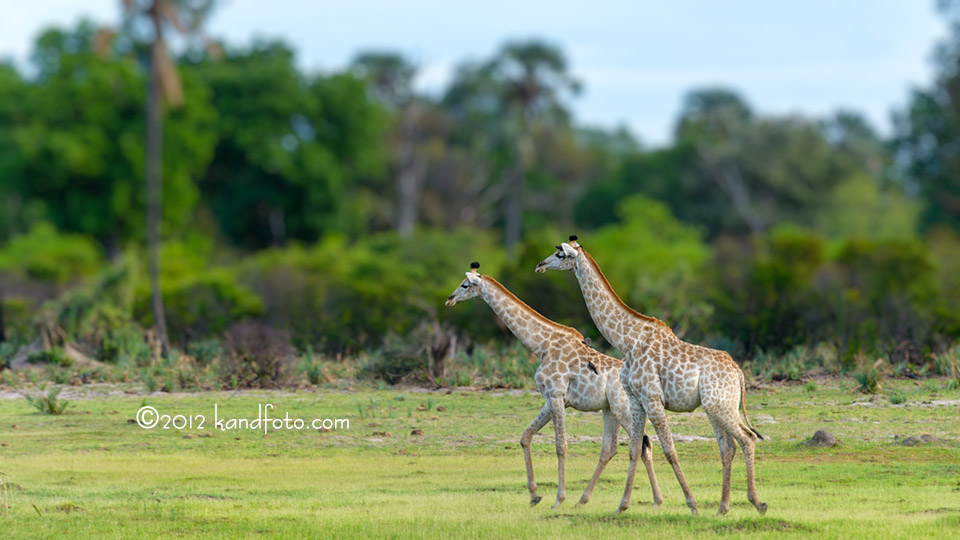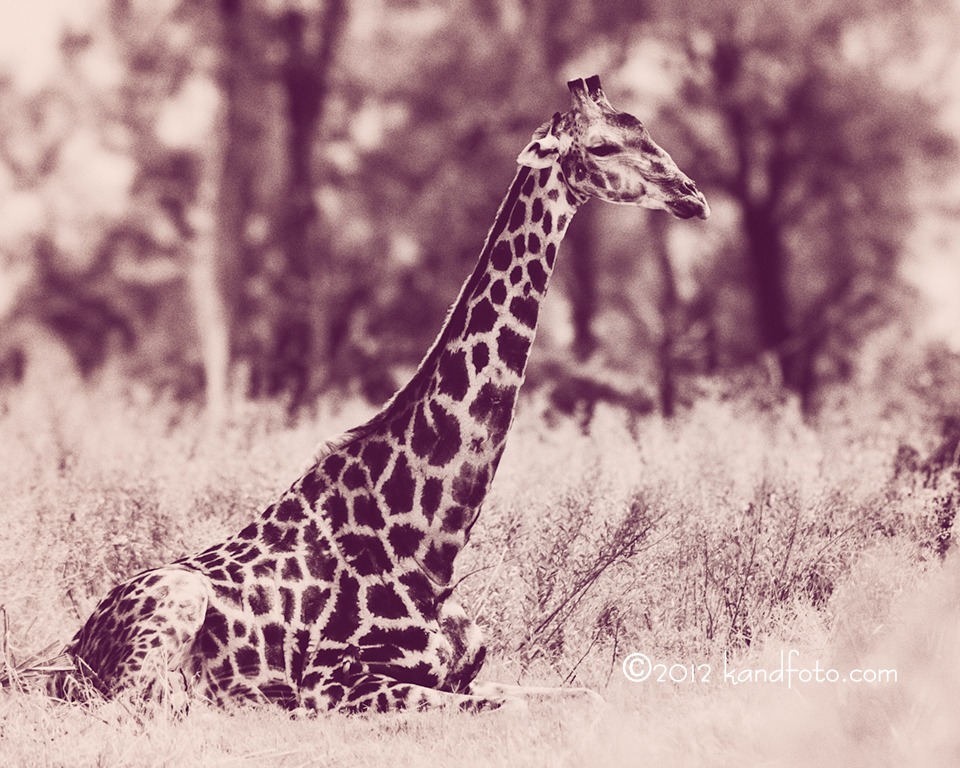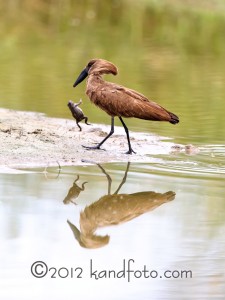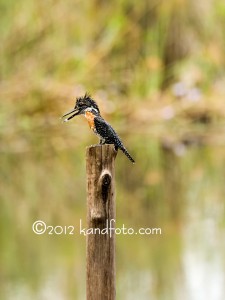Part III in the Series of My African Photo Safari
November and early December are a fantastic time to be in bush in the Okavango Delta. It’s special to see all the babies . . . zebras, elephants, impalas, tsessebe, lions, baboons, etc. The vibrant colors of migrant birds are present, and most importantly, the skies are so dramatic with thick, puffy white clouds reaching high in the sky. Just imagine seeing the African landscape in wide screen, techno-color with a splash of lush green, bright oranges and reds.
Giraffes
The giraffe gives a deceptive impression of ungainliness—but watch one in stride with its long, loping gallop and you see a paradigm of power, a kind of imperial grace.
Elephants
Elephants are extremely intelligent animals and have memories that span many years. They also display signs of grief, joy, anger and play. They form deep family bonds and live in tight matriarchal family groups of related females called a herd. The herd is led by the oldest and often largest female in the herd, called a matriarch. Herds consist of 8-100 individuals depending on terrain and family size. Calves are protected by the entire herd so when planning on photographing elephants you must be aware of the dangers posed.
Bee, our field guide and driver at Nxabega Tented Camp, took us to a fairly large herd of elephants which he knew had some babies just recently borne. Closer we told Bee, and he delivered. He took us off road into the bush, shrubs, sticks, mowing down everything in sight. I thought for sure we were doomed—lost in a herd of “pissed off” elephants. We were so close that I switched to my Nikon D600 with the 70-200mm lens. One angry mother with her baby close at hand thought we might be a wee bit too close (I thought so too). She became quite agitated, flapping her large ears and throwing her trunk up into the air, trumpeting her displeasure. Even the boy calf danced around doing his “fake” charged at our vehicle. I wasn’t too worried about the baby since he only came to the top of our vehicle but the mother was another story. I turned to Bee, exclaiming that we needed “PLAN B,” an exit plan. “Don’t worry, Miss Kandy,” he said, “I can read these animals.” Really?
Zebras
Arguably the most distinctive feature of a zebra is its COAT of many stripes . . . it’s an unique fingerprint just like humans —no two are exactly alike—although each of the three species of zebra has its own general pattern. Scientists are not completely sure why the stripes . . . camouflage seems to be the consensus though. However, it may be to help zebras recognize one another.
Zebras are social animals that spend time in herds or in a “harem.” Plains and mountain zebras live in harems—consisting of one stallion and his mares and their young. They graze together and even groom one another. If a predator is spotted, they will bark or whinny loudly to warn the others in the harem.
Of all the animals that I photographed, the zebra was the hardest . . . always at a distance, ready to run at any given notice. Seldom was I lucky enough to get really close, even though Bee was capable enough to charge us in, full speed, damn the torpedos! My dream was a reflection of zebras drinking at the water hole, lined up in unison. Maybe next year, I will be lucky.
Botswana’s Other Wildlife
Botswana’s watery landscape of the Okavango Delta, its game-rich parks and reserves, and its famous Kalahari Desert comprises an impressive diversity of habitats. Even though I was not in a location to observe and photograph one of the world’s most heralded large herbivores, a mammal whose plight has recently attracted more media attention than an A-list celebrity, there are still 40 to 50 majestic rhinoceros in northern Botswana. I’ll be back in 2014 in search of the rino.
A menagerie of antelope, baboons, warthogs, awaits you in my blogshow. ENJOY!
Our Feather Friends of Africa
When I started researching what lens would be best for an African photo safari, most professional photographers recommended the 200-400mm lens as their powerhorse on the African plains. I had the new Nikon 500mm, f4, VRII, which always serves me well . . . its a super sharp fast lens for all of my field adventures . . . Alaska, Winter in Yellowstone, and for shooting hummingbirds, whooping crane, sandhill cranes, and migrating birds in South Texas. Super telephoto lenses are expensive, and I could have rented a 200-400 lens but, mostly, its the weight restrictions hauling another big lens around that squashed that idea.
I brought my 500mm lens. Boy, was that the best decision I made—it gave me that extra ump I needed when the subject was not as close as I liked, i.e., the zebras. But, for bird photography, it was the big jewel in my box of diamonds. Birds are not easy to photograph even when your in a blind but to get them in the field, in a loud Land Cruiser, well, it’s all most impossible.
At Nxsbega Tented Camp, we drove out each day pass a good sized pond. This particular morning, the pond was full of birds so we decided to stop for awhile to photograph birds. We had kingfishers, storks, hamerkops, shore birds, herons, and a few hippos. Bee, as always, manuvered us in without getting stuck in the mud to a nice spot.
The hamerkop is an interesting shaped bird with a lethal beak. He picked up this poor frog who was literally beaten to death. This bird threw this frog around, pounded it, pecked at it for at least 30 minutes. And, Bee told us this is how the hamerkop kills and eats its prey. Next to be eaten alive by hyenas or wild dogs, this would be a horrible way to die. Of course the Yellow-billed stork was actually just as bad . . . he took, it seemed forever. to eat the fish. I had my 500mm lens focused on this stork just waiting for him to swallow whole this fish he had caught. With finger on the shutter, waiting, waiting, watching, watching, and what does Bee decide to do—MOVE THE FRIGGING CRUISER just as the stork takes his big gulp!
CHECKED . . . another lost shot.
How I Photographed in Botswana
And, for all those times that the subject was too close for the 500mm lens, I grabbed my 70-200mm lens. It’s a zoom lens with all the features of a prime lens. You can attach a teleconverter to it for one. Its fast, its not as heavy as a super prime lens, and it gives you the zooming capability without losing quality. IMHO, I believe that Nikon makes the best glass (cameras debatable), and there is no argument when it comes to the Nikon 70-200mm, f2.8, VRII lens. It should be in every photographer’s camera bag who is serious about wildlife photography.
For Africa, since I had such back issues, I was permanently staged in the front seat next to the driver. Being in the front seat came with its own set of problems . . . Yes, I was lower to the ground but I lacked the mobility that the other photogs had with a row all to themselves. Of course, there was the shrub/weeds problem as well. Oh, and did I mention the antenna? For stablity—my husband strapped in the tripod to the door with the bungie cords. I used pads and blankets between the two seats for support so that I had my 500mm and my 70-200mm right beside me and always ready to go.
Recap of Photographic Lens and Cameras for a African Photo Safari
- Nikon 500mm, f4, VRII, lens attached to a Nikon D3
- Nikon 70-200mm, f2.8, VRII, lens with a 1.4x teleconverter attached to a Nikon D600
- Nikon 24-70mm, f2.8, VRII, lens or the Nikon 16mm Fisheye or the Nikon 12-24mm lens, attached to a Nikon D7000
- Nikon 1.7x teleconverter
- Wimberley WH-200 Ballhead
- Gitzo GT3540LS 6X Carbon Fiber Tripod
- Nikon SB-900 Speedflash with fash extender
- various bungie cords
- Singh-Ray Grad ND filter (3-stop), B+W polarizer
- Gura Gear Camera Bag
- Gura Gear Computer Bag
- 13″ MacBook Pro
- 2-1TB External Portable Hard Drives
- Portable Sensor Cleaning Tool Kit/Blower






















This is a test to resolve the comment section issue.
Okay, the comments are working again.
I loved the close up picture of the zebra. I may have to buy that from you. But I also loved hte picture of the three zebras. Maybe it’s my OCD, but it’s just such a fantastic shot with the colors even if there are really only two colors.
I can’t decide if I love the Mamma elephant and her baby close up picture more or the fixed up effects picture of the elephant coming out of the grass. Both great. Well done.
It seems that I have gotten the “comment’ section working again. Now, I will try to get the “follow” button back in the blog.
I would have put my money on you liking the mother baboon and her baby riding under her belly.
Hi Kandace,
Your photos are absolutely terrific. I cannot believe some of the shots you have of such ferocious wild animals. I am praying you are using ultra strong zoom lenses, but I fear you are closer than I would feel comfortable with. Am I right? Of course, it is for art’s sake I suppose you tell yourself. My nerves are shot just thinking about it and hearing of the two people attacked by lions this past week. Just saying! I also loved how you used different lenses for different effects. That just totally changes the mood and feeling of the photo. I get a different perspective. You can really see how you are growing and developing your art in these photos. Plus, when I read how you waited to capture a certain photo, I am impressed. Poor Bee who moved just when you were ready to take the shot.
While I have very little understanding of the different lenses you are using, I can appreciate the thought you have to put into your equipment. I would love to pick your brain on photographic equipment for my family. I am finally going to become a grandmother in a few months, and I would love a really good camera to take pictures of my grandchild. Plus, I would like a camera to take pictures of my daughter’s desserts and chocolate sculptures. Do you have any thoughts on what would be good and what kind of lens we should use? We were love your insight.
I signed up for your blog, so now I can keep up with your exciting and scary adventures.
Thanks so much for sharing these photos with us. I send them on to Les and friends who will enjoy seeing them.
Marcia
Wow Kandace, nice shots! You have a talent for capturing interesting “life moments”: the frog leaping by the bird for example or the bird eating the worm. I’m curious, how many shots in rapid succession does it take to get one of those? Were it me, I’d be firing shots like mad and probably toss out 50 shots for every good one – at least!
Greg, that’s the Hamerkop killing his prey by crushing the poor frogs little bones.
Thank you for taking the time to read the post. I hope your trip sailing the world is coming out like you planned. I’m glad you got to the Great Barrier Reef, its so beautiful.
I shot with a Nikon D3, which fires about 9 frames per second. And, yes, that’s what it takes to get those action shots. You just start firing when the action starts in hopes that you get some good shots. In the my post, Amazing Cats of Botswana, the leopard was in the tree before I could even get one shot off. Bummer!